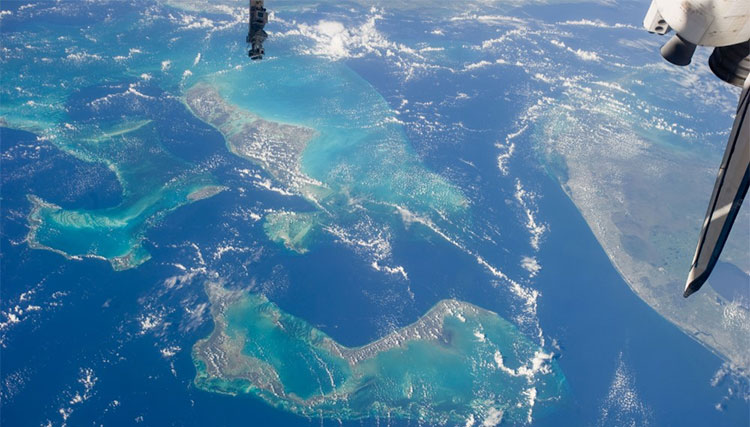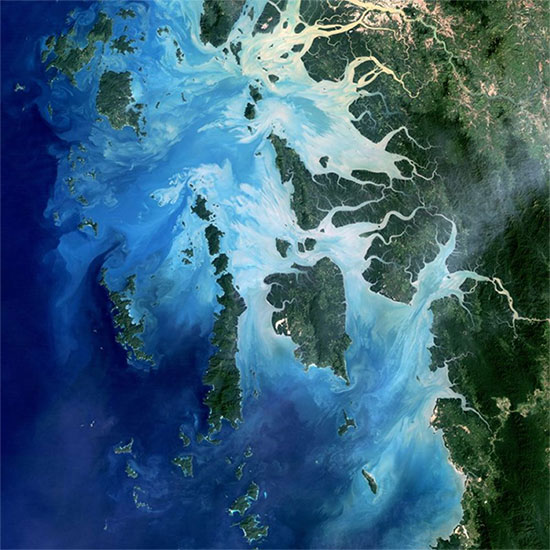Deep blue of sea water is a sign of death
The sea water is obviously not blue. The blue of the ocean only reflects the depth, the components that make up the sea there and what is below the sea surface.
If you have the opportunity to travel to different seas in the world, you will probably realize that water color in each sea is different . Why is the ocean so green?
To answer this question quickly, NASA oceanographer Gene Carl Feldman pointed out: 'The sea water is obviously not blue. The blue color of the ocean only reflects the depth of the water there, the components that make up the sea there and what's below the sea surface . "

Seawater has different colors in different places due to many factors.(Photo: NASA).
To help you better understand, start with a glass of water. Place a glass of water on the table and you will easily see things on the other side of the glass, that is because light can pass through without being or having very few obstacles. But if it's not a glass of water, but a deep enough water so that the light can't reach, it will be blue.
Explain basic physics: Sunlight is made up of 7 spectra with different wavelengths that the human eye can see. Longer wavelengths are red and orange, while blue and green are shorter wavelengths. When the Sun shines on the ocean, light interacts with seawater and is absorbed or dispersed.

Satellite images of Mergui Islands show a marked change in water color.(Photo: NASA).
Let's assume that seawater is only made of pure water, this process will take place as follows: light with long wavelengths of red and orange will be absorbed almost at the surface and then gradually disappear in layers. The next water, while light with short wavelengths, is blue that is not so much absorbed but still goes deep, scattering into the water and causing the ocean water to be blue.
The depth and bottom of the ocean also affect the ocean's blue color . For example, the Atlantic Ocean is very dark blue, but the ocean in tropical climates is bright blue like sapphire. 'In Greece, seawater is as beautiful as turquoise because its sea floor is made of white sand and white stone. Light shines into the sea, touches the sea floor and reflects back and creates such color, ' Feldman explained.
The color of the sea also shows its status
In addition to the influence of the depth, seabed or seawater composition, another factor affecting the sea color is the 'health' of the ocean. This is a factor represented by seawater pollution, that its internal environment is good for marine organisms to grow or not.

Sediment along the coast of Cádiz Bay, Spain.(Photo: NASA).
Oceanographers monitor the color of the ocean as doctors monitor the health status of patients, and realize that this change is closely related. Contaminated sea areas that carry the color of seawater are much different from clean seas.
Gene Carl Feldman spent a lot of time watching photos from the SeaWiFS satellite at a height of 644km above the ground from 1997 to the present. Most photos are beautiful, looking like Van Gogh's painting. Some places appear sediment, its flow creates a dull brown color; Running along the sediment is small plankton, they live here and create green for the sea.

Cat Island, Bahamas Islands were taken from the International Space Station in 2011. (Photo: NASA).
'Phytoplankton use chlorophyll to collect energy from the Sun and exchange carbon dioxide to create oxygen, this process called photosynthesis and creating breathing air for marine life and terrestrial animals, in it has people. This is an element of healthy waters, ' Feldman said.
Green looks like dirty and unfriendly like the traditional blue of water, but it is obviously a sign that the sea is still alive. Plankton are prey to larger fish, which attracts fish migration and creates a bustling habitat.

Phytoplankton create sea whirlpools in the Baltic Sea around the Swedish island of Gotland.(Photo: USGS / NASA).
During the past 50 years, oxygen-free seas have increased rapidly and expanded into a region four times larger than Europe (4,475,755 square kilometers). Part of the main reason is due to the rise in temperature in seawater, the warmer water makes the organism unable to live and produces oxygen.
'Phytoplankton are small but play an important role in the food chain of the marine environment. If they cannot survive, the waters will not have oxygen and will lead to other fish species not moving there, thus forming a dead sea.
In the dead sea areas, the sea water will have a very dark blue color. Sunlight kept going straight down and going to the deepest place to disappear, without any life form that prevented it on the way, this was probably the deepest and deadliest blue you ever had. know, ' Feldman said.
- The green hole is 20 meters deep off Australia
- Heartbreaking image of the death of blue whale
- The world's largest 50-year-old white shark, Deep Blue
- The fish community is forgotten in the deep sea
- Ways to cure blue screen errors
- Video: Blue whale wearing the whole boat jutting out of the water
- Blue whales rotate 360 degrees to hunt
- Pluto has 'blue sky' and ice water
- New sign of life in Mars
- May 11, 1997: Kasparov grandmaster is defeated by supercomputer Deep Blue
- Why is the ocean blue?
- The scientific world has captured the image of the god of death.
 Surprised: Fish that live in the dark ocean still see colors
Surprised: Fish that live in the dark ocean still see colors Japan suddenly caught the creature that caused the earthquake in the legend
Japan suddenly caught the creature that caused the earthquake in the legend A series of gray whale carcasses washed ashore on California's coast
A series of gray whale carcasses washed ashore on California's coast Compare the size of shark species in the world
Compare the size of shark species in the world